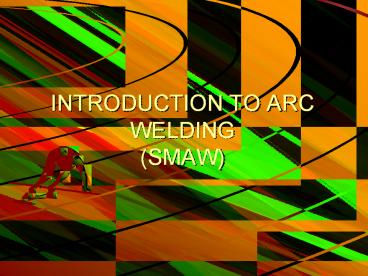INTRODUCTION TO ARC WELDING (SMAW) PowerPoint PPT Presentation
Title: INTRODUCTION TO ARC WELDING (SMAW)
1
INTRODUCTION TO ARC WELDING(SMAW)
2
Terms Definitions
- Welding - Joining of two or more pieces of metal
together by the fusion process - NOTE In arc welding, heat is produced by the
electric arc created. - SMAW - Shielded Metal Arc Welding
- Electrode - Metal rod which conducts a current
from the electrode holder to the base metal - Base Metal - Metal to be welded
3
Continued
- Bead Weld - Made by one pass of the electrode
- Bevel Type of edge preparation containing an
angle - Butt Joint - Weld located between the two edges
of metal. - Crater - Depression at the end of a weld
4
Safety precautions in SMAW welding
- Never look at the arc with the naked eye.
- Use a welding hood that is in good condition and
has a 12 shade. - Wear suitable clothing to protect all parts of
the body. (PPE) personal protective equipment - Long sleeved shirt
- Leather gloves
- Collar buttoned
5
Continued
- Cuffs turned down
- High topped shoes or boots
- Do not strike an arc or weld until you are sure
those in the vicinity have protective equipment
or will look in the other direction. - (Note) Yell cover before striking an arc.
6
Continued
- Do not weld around combustible or flammable
materials. - Do not pick up hot metal with the hands.
- (NOTE) Use a pair of pliers
- Do not weld in confined places without ventilation
7
Continued
- Always turn off main switch or disconnect plug
when checking over a welder. - Do not leave electrode holder on the welding
table or in contact with grounded metal. - Do not use worn or frayed cables.
8
Continued
- Stand on dry footing when welding.
- Keep area around welder clean.
- Keep tools and metals in proper location.
9
Types of Arc Welders
- A.C. (Alternating current) Welder current
alternates direction 120 times per second. - D.C. (Direct current) Welder current flows in
the same direction. - TIG (Tungsten Inert Gas) Welder may use either
A.C. or D.C. with a non-consumable tungsten
electrode and an inert shielding gas.
10
Continued
- MIG (Metal Inert Gas) May use A.C. or D.C.
with a base wire filler material that is fed
automatically into weld also has an inert
shielding gas.
11
Common SMAW Tools
- Welder
- Electrode Holder
- Ground clamp
- Shield or helmet
- Gloves
- Chipping hammer
- Safety goggles or glasses
- Wire brush
- Electrodes
12
Types of Electrodes
- Mild Steel
- High Carbon Steel
- Hard Surfacing
- Alloys special purpose
13
Electrode Characteristics
14
Electrode Characteristics continued
15
Common Sizes of Electrodes
- 1/8
- 5/32
- Sizes of electrodes range from 1/16 to 3/8.
- Electrode size is determined by the diameter of
the wire core.
16
AWS Classification
E70XX-H4R
- Electrode
- Tensile in Ksi
- Welding Position
- 1 All Position, 2 Flat Horizontal
- Type of Current and Coating
- Hydrogen
- H4 Less than 4ml/100g weld metal, H8 Less
than 8ml/100g Weld Metal - or H16 Less than 16ml/100g weld metal
- Meets Requirements of Absorbed Moisture Test
- Optional Designators
17
Electrode Coating Functions
- To Provide Deoxidizers Scavengers
- To Produce Shielding Gases
- To Produce a Slag Covering
- To Provide Mechanical and Physical Properties
- To Increase Deposit Rates
18
Effects of Raising Lowering Current
- Raising current
- Produces more heat
- Lowering current
- Produces less heat
- (Note On thicker metals more heat is necessary
in order to get penetration of the weld.)
19
Methods of Establishing an Arc
- Scratching
- Similar to striking a match
- Tapping
- Straight down and up
20
Characteristics of Proper Arc Length
- End of electrode is the same distance from the
base metal as the diameter of electrode. - 1/8 electrode arc length 1/8
- Correct arc length makes a steady hum of the
welder. - Correct arc length makes a frying sound at the
arc - Like bacon frying in a pan
21
Parts of the welding process
- Electrode
- Wire core
- Coating (flux)
- Arc
- Gaseous shield
- Weld
- Slag
22
Parts Continued
- Heat lines
- Base metal
- Penetration
- Crater
- 15 30 degree angle
- Direction of travel
23
Principles of the SMAW Process
24
Kinds of Welds
- Fillet
- Groove
- Bead
25
Fillet Weld
26
Groove Welds
27
Continued
28
Types of Weld Joints
- Butt Joint
- Lap Joint
- Tee Joint
- Corner Joint
- Edge Joint
29
Square Butt Joint
30
Tee Joints
- A- plain tee
- B- single beveled
- C- double beveled
- D- single J
- E- double J
31
Lap Joints
- A- single lap joint, one weld.
- B- single lap joint, two welds.
- C- offset lap joint.
32
Corner Joints
33
Edge Joints
34
Welding Positions
- Flat
- 1F 1G
- Horizontal
- 2F 2G
- Vertical
- 3F 3G
- Overhead
- 4F 4G
35
Weld Positions
36
Reason for Poor Welds
- Machine adjustment too hot or too cold
- Electrode size too large or too small
- Improper movement of electrode
- Improper angle of holding electrode
- Improper base metal preparation
- Arc length too long or too short

